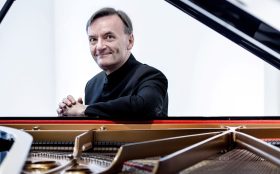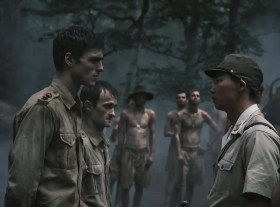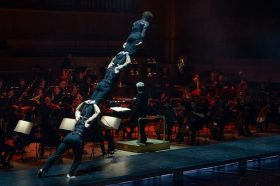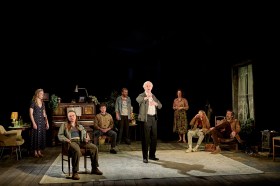Cast your mind back to an eventful BBC Prom in 2003. Silence that speaks of anticipation fills the Albert Hall. The perfectly placed bassoon solo effortlessly sails to the furthest corners, drawing listeners into the beautifully crafted unfolding of Stravinsky’s Rite of Spring. A mobile phone starts ringing – as out of place and irritating as that Trigger Happy TV ring tone – but I doubt the owner had any intention of referring to that at this Concert (with a capital C) of concerts performed by the Berlin Philharmoniker. If esteemed conductor Simon Rattle found it funny he did an extremely good job of hiding it as he hung his head, as if in despair with the human race, before ending the performance and starting again.
The audience that evening stood divided between those who stifled stunned laughter and those who stifled rage. What is undeniable is how this incident highlights the crucial importance of the unspoken ‘Rules and Regulations’ of the concert hall:
No.1. DO NOT clap between movements
No.2. Snacks/drinks (especially those with noisy packaging) are not permitted in the auditorium
No.3. Feet tapping/head bobbing is unacceptable
No.4. No children allowed, unless gagged and tied to their chair
No.5. No social interaction/dialogue between lowly audience and almighty performer/conductor.
I could go on, but the long list is a bit daunting to be honest.
Despite the outcry at this particular concert, the Proms are unique in that these rules are generally loosened. After all, you can’t really expect people to stand motionless and silent in exactly the same spot for a few hours. It is this informal atmosphere as well as the amazing programme is why it is so popular.
This year’s Prom Season will see premieres such as John Adam’s Doctor Atomic Symphony, the London Premiere of Thomas Ades Powder Her Face and a late night prom featuring the BCMG performing Oliver Knussen alongside Webern and Julian Anderson. Particularly memorable in my mind is last year’s Prom 37 of Steve Reich music, featuring Drumming and Music for Mallet Instruments, Voice and Organ. It was given a late night spot at 10.15pm and almost had the atmosphere of a prequel to late-night raves, with audience members moving to the repetitive beats, almost succumbing to the trance-like state which such music inflicts.
Concerts of contemporary classical music are gradually moving away from traditional venues and therefore from traditional conduct, and about time too! The use of media, music theatre, performance art and unconventional instrumentation in some compositions means that the traditional concert hall doesn’t always accommodate the needs of certain performances. Despite this, the traditional venues – and with it the inherited code of conduct – are considered standard. It is a bizarre experience to sit in an auditorium watching someone twiddle buttons at a sound desk for example, and it seems oddly disconnected from the sounds coming from speakers placed around the hall, however meaningful the music itself is. It is a similarly isolating experience at some acoustic contemporary pieces as well, where performers might be purposefully placed around the hall, out of sight of the audience or Minimalist pieces that go on for hours while the audience are expected to stay glued to their seats.
This is obviously not the ideal platform for performers and composers to play their work, and refreshing alternatives are arising. The Rational Rec. series started up in October 2005 and has literally taken Contemporary Music and Arts down the pub. Bethnal Green Working Man’s Club, to be precise.
The 2006-2007 series was awarded funding by Arts Council England and has grown in audience numbers as well as media interest, so much so that it will be included in a BBC4 documentary entitled Cool Britannia this month. Performances are framed by pub quizzes, video footage, birthday cake and chat with your mates and the idea is to get ‘alcoholically, intellectually and musically stimulated’. Music and performance art happens on stage, in the middle of groups of busy tables and in front of the bar and the evening is all hosted by Matthew Shlomowitz, Russell Martin and Cecilia Wee.
The evenings might include live interviews, compositions for desk bells, cellos linked to video consoles and scraping and plucking piano. The nuances of this performance of Guero by Helmut Lachenmann, came across brilliantly in such an intimate setting and there were no worries about battering the already world weary piano that resides in the Club. But more than that, the atmosphere was one of ‘anything goes’, letting this performance and others exist free from expectation and pressure that can come with the pretension of traditional showcases. ‘We wanted to create a space for the presentation and discussion of new work by artists in various disciplines in a friendly yet professional environment.’ says Cecilia Wee, one third of the brains behind Rational Rec.
SPNM have also been progressing the scope for contemporary music venues though the bi-monthly ‘The Sound Source’ series, which allows different ensembles/artists to feature music from a range of sources in the Institute of Contemporary Arts. In addition to this, the Solo Spotlight series from artistic director Rolf Hind which ran through to June this year took place in the Wapping Hydraulic Power station. Each concert featured a solo musician performing music designed specifically to explore their instrument-being harp, harpsichord, violin and percussion-to its full potential. No doubt this may have been considered a cheap novelty device by those advocates for the ‘serious’, academic appreciation of music. But who says this can’t be done in alternative venues? And if it incorporates design by multi-media artist Julia Bordsley, all the better. What can’t be denied is that this ‘feast for the senses’ certainly appealed to a larger audience who would be attracted to the venue and might usually be intimidated by the pressure of attending a musical concert, particularly if the music is unfamiliar.
Of course, the traditional concert hall lends a sense of occasion to a musical performance, as well as a respect for the composer, but this is only derived from tradition and doesn’t always make sense to the music being performed. Scandinavian Jazz trio EST performed in the Barbican in March to large audience, which I’m sure they were thrilled with. Although they put on a great visual show and were, as always, a complete pleasure to watch, I couldn’t help wishing I was in a more informal venue where I could actually see the performers rather than watch their image on screen, and where I could share the experience with the people I went with instead of sitting in a row facing the same way.
I doubt composers would be happy if confined solely to the pub purely because of experimental ideas. But physical space should be considered on a piece by piece basis, as an element that can illuminate music for the listener. For longer, orchestral pieces, it is highly unlikely that something more suitable than a concert hall will work. But for pieces with fewer players, the music can be brought to another level when performed in an unconventional and less formal venue. This would also have the advantage of appealing to a wider audience, for whom the idea of sitting though a few hour long concert with no toilet breaks sounds too much like hard work.
What is very telling is that only one of the three organisers of Rational Rec. has a background specifically in Music. This diversity has surely impacted the content and exhibition of their artistic performances and has been influenced by visual and performance art which have a history of being more experimental with physical space. The importance of placing and space are an enormous factor in the way we perceive visual art in a gallery. Contemporary theatre productions have also embraced the exploration of literal space by breaking the 4th wall between audience and players. It is only a matter of time before contemporary music lovers will demand the same attention.




_Encounters-in-Reflection_Gallery3BPhoto-by-Anpis-Wang-e1745414770771.jpg?w=280)